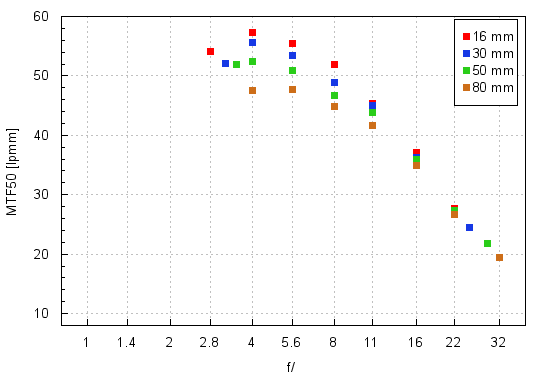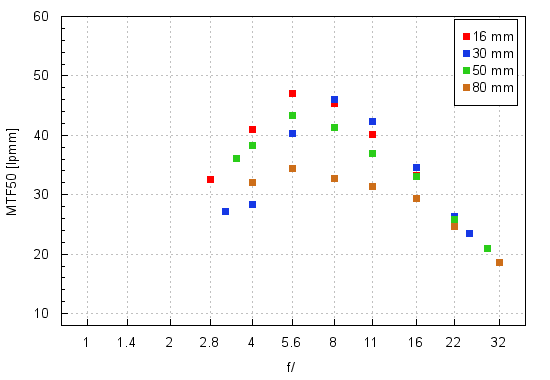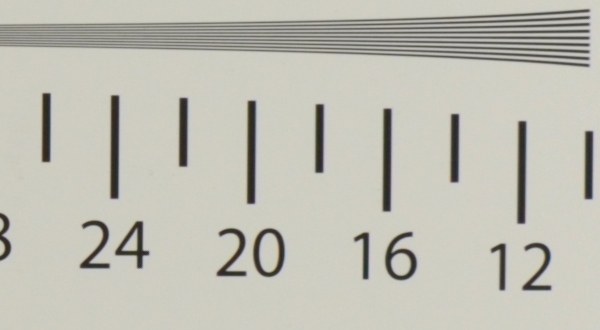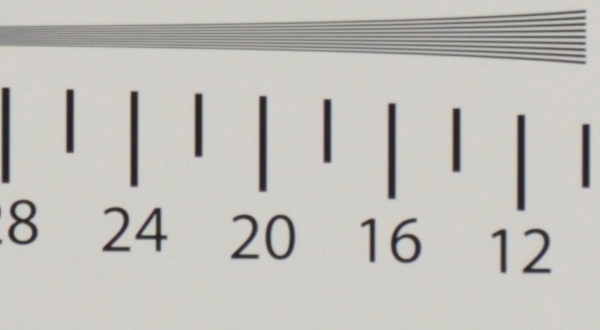Nikon Nikkor AF-S DX 16-80 mm f/2.8-4E ED VR
4. Image resolution
Let’s check how the tested Nikon fared in the frame centre – the appropriate values at the 16, 30, 50 and 80 mm focal lengths are presents a graph shown below.

Please Support UsIf you enjoy our reviews and articles, and you want us to continue our work please, support our website by donating through PayPal. The funds are going to be used for paying our editorial team, renting servers, and equipping our testing studio; only that way we will be able to continue providing you interesting content for free. |
- - - - - - - - - - - - - - - - - - - - - - - - - - - - - - - - - - - - - - - - - - - - - - - -
The 16 mm focal length might be described solely in superlatives. Not only the results reach over 54 lpmm already at the maximum relative aperture but on stopping down you are able to get close to 57-58 lpmm so values worth the best fixed focus instruments. Here the lens fares exceedingly well.
Unfortunately the tested Nikkor doesn’t show an even performance and with the increase of the focal length its results get worse. In the 30-50 mm range you don’t have any reasons to complain because at the maximum relative aperture you are still above 50 lpmm and on stopping down you get excellent MTFs ranging from 52 to 56 lpmm.
The weakest performance, but overall not so bad at all, you can observe at 80 mm. By f/4.0-5.6 the MTFs exceed 47 mm so they are still very good.
In the frame centre the lens fares exceedingly well and those values are especially worth emphasizing as, for a zoom of this type, the tested Nikkor provides a very useful range of focal lengths and good aperture fastness.
So far, so good. Will you be equally satisfied after examining the performance on the edge of the frame? Let’s find out.

Unfortunately it won’t be the case. Firstly the lens shows an even bigger scattering between the results you get at different focal lengths than in the frame centre. Secondly the maximum relative aperture leaves a lot to be desired across the whole focal range, never approaching even the decency level. In the case of the shorter focal end you have to stop down the aperture by about 1-1.5 EV in order to make the image useful. The maximum focal length is the biggest problem here – the images it generates are simply weak, no matter how much you stop down the aperture.
As you see after praising a lot the frame centre the performance of the lens on the edge disappointed us. It is not a megazoom to tolerate such slip-ups on the edge of the frame. For such an amount of money you really should expect something better.
Traditionally we end this chapter by presenting crops taken from the frame centre of our testing scene photos. It should be reminded that these are JPEG files straight from the camera which were saved along with RAW files, described above.
| D7000, JPEG, 16 mm, f/4.0 |
 |
| D7000, JPEG, 80 mm, f/4.0 |
 |






